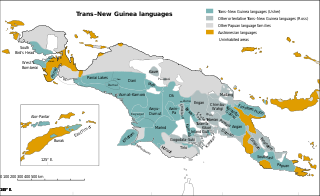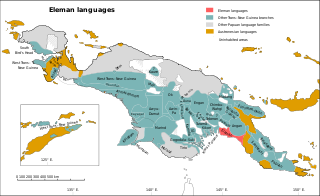Related Research Articles

Trans–New Guinea (TNG) is an extensive family of Papuan languages spoken on the island of New Guinea and neighboring islands, a region corresponding to the country Papua New Guinea as well as parts of Indonesia.

The Papuan languages are the non-Austronesian languages spoken on the western Pacific island of New Guinea, as well as neighbouring islands in Indonesia, Solomon Islands, and East Timor. It is a strictly geographical grouping, and does not imply a genetic relationship.

The Kiwaian languages form a language family of New Guinea. They are a dialect cluster of half a dozen closely related languages. They are grammatically divergent from the Trans–New Guinea languages, and typically have singular, dual, trial, and plural pronouns.

The South Bird's Head or South Doberai languages are three families of Papuan languages. They form part of the Trans–New Guinea languages in the classifications of Malcolm Ross (2005) and Timothy Usher (2020), though Pawley and Hammarström (2018) do not consider them to be part of Trans–New Guinea. However, according to Dryer (2022), based on a preliminary quantitative analysis of data from the ASJP database, South Bird's Head languages are likely to be a subgroup of Trans–New Guinea.
The Kutubuan languages are a small family of neighboring languages families in Papua New Guinea. They are named after Lake Kutubu in Papua New Guinea.

The Eleman languages are a family spoken around Kerema Bay, Papua New Guinea.

The Inland Gulf languages are a family of Trans–New Guinea languages in the classifications of Stephen Wurm (1975) and Malcolm Ross (2005). The unity of the languages was established by K. Franklin in 1969. Although the family as a whole is clearly valid, Ipiko is quite distinct from the other languages.

The Turama–Kikorian languages are a family identified by Arthur Capell (1962) and part of the Trans–New Guinea languages (TNG) family in the classifications of Stephen Wurm (1975) and Malcolm Ross (2005). The family is named after the Turama River and Kikori River of southern Papua New Guinea; the alternative name is based more narrowly on the Omati River.

The Teberan languages are a well established family of Papuan languages that Stephen Wurm (1975) grouped with the Pawaia language as a branch of the Trans–New Guinea phylum.

The Duna–Pogaya (Duna–Bogaia) languages are a proposed small family of Trans–New Guinea languages in the classification of Voorhoeve (1975), Ross (2005) and Usher (2018), consisting of two languages, Duna and Bogaya, which in turn form a branch of the larger Trans–New Guinea family. Glottolog, which is based largely on Usher, however finds the connections between the two languages to be tenuous, and the connection to TNG unconvincing.

The Bosavi or Papuan Plateau languages belong to the Trans-New Guinea language family according to the classifications made by Malcolm Ross and Timothy Usher. This language family derives its name from Mount Bosavi and the Papuan Plateau.

The East Strickland or Strickland River languages are a family of Papuan languages.
The Mailuan or Cloudy Bay languages are a small family of Trans–New Guinea languages spoken around Cloudy Bay in the "Bird's Tail" of New Guinea. They are classified within the Southeast Papuan branch of Trans–New Guinea.

Wiru or Witu is the language spoken by the Wiru people of Ialibu-Pangia District of the Southern Highlands Province of Papua New Guinea. The language has been described by Harland Kerr, a missionary who lived in the Wiru community for many years. Kerr's work with the community produced a Wiru Bible translation and several unpublished dictionary manuscripts, as well as Kerr's Master's thesis on the structure of Wiru verbs.
Kaki Ae, or Tate, is a language with about 500 speakers, half the ethnic population, near Kerema, in Papua New Guinea. It was previously known by the foreign designation Raeta Tati.

Pawaia, also known as Sira, Tudahwe, Yasa, is a Papuan language that forms a tentative independent branch of the Trans–New Guinea family in the classification of Malcolm Ross (2005).
Kiwai is a Papuan language, or languages, of southern Papua New Guinea. Dialects number 1,300 Kope, 700 Gibaio, 1,700 Urama, 700 Arigibi, 3,800 Coast, 1,000 Daru, 4,500 Island, 400 Doumori. Wurm and Hattori (1981) classify Arigibi as a separate language.
Asmat is a Papuan language cluster of South Papua.
Karami is an extinct and unclassified Papuan language of southern Papua New Guinea. It is attested from only a short word list, which include many loans from Foia Foia.
Dibiyasoa.k.a.Bainapi is a Papuan language of Western Province, Papua New Guinea.
References
- 1 2 Pawley, Andrew; Hammarström, Harald (2018). "The Trans New Guinea family". In Palmer, Bill (ed.). The Languages and Linguistics of the New Guinea Area: A Comprehensive Guide. The World of Linguistics. Vol. 4. Berlin: De Gruyter Mouton. pp. 21–196. ISBN 978-3-11-028642-7.
- ↑ Purari at Ethnologue (18th ed., 2015) (subscription required)
- 1 2 New Guinea World, Oro – Wharton Range
- 1 2 Petterson, Robert. 2019. Interesting Features of Porome: An Isolate Language of PNG . Paper presented at the LSPNG 2019 Conference. 30pp.
- 1 2 3 Holmes, J. H. (January–June 1913). "A Preliminary Study of the Namau Language, Purari Delta, Papua". Journal of the Royal Anthropological Institute. 43. Royal Anthropological Institute of Great Britain and Ireland: 124–142. doi:10.2307/2843165. JSTOR 2843165.
- ↑ Franklin, K. J. "Other Language Groups in the Gulf District and Adjacent Areas". In Franklin, K. editor, The linguistic situation in the Gulf District and adjacent areas, Papua New Guinea. C-26:261-278. Pacific Linguistics, The Australian National University, 1973. doi : 10.15144/PL-C26.261
- ↑ Greenhill, Simon (2016). "TransNewGuinea.org - database of the languages of New Guinea" . Retrieved 2020-11-05.